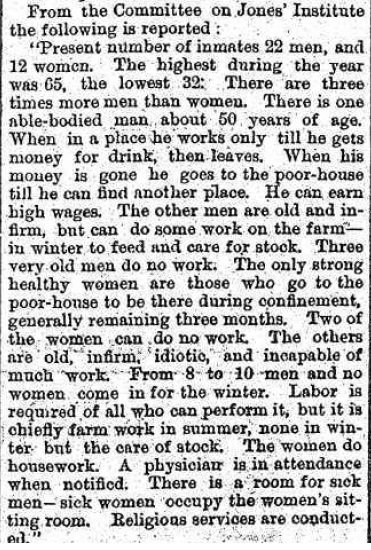Ready...Set...Oops!
Alas, any planning assumptions made in 1836 were thwarted by the nationwide Panic of 1837. The prolonged economic crisis led to a number of disastrous results, including the LIRR's stopping construction of the railroad where things were, and thereby unintentionally founding Hicksville.
For the Oyster Bay and North Hempstead Town Almshouse, as it was then called, the market crash was fatal - if not to the farm itself, then to Samuel Jones's plan that it would forever survive without tax support. For it to do that, the Jones Fund's investments would have to earn regular income. The money had been invested quite conservatively, much of it in Brooklyn real estate. Those investments would generate a steady stream of revenue as the Fund's tenants made their rental and lease payments.
The panic, however, was both sudden and severe. Individual tenants soon lost their jobs, and corporate tenants quickly went bankrupt. Income from real estate holdings was at best a pittance. There was no recourse; the trust would have to weather the panic, paying what little it could to keep the Almshouse residence going. Within a year, the Towns had to start funding its deficits. From time to time, private individuals, including some members of the Jones family, added to the Fund's capital in order to keep it afloat.
Things gradually stabilized, but public assistance would almost always be needed after that. The Towns continued to provide funding, as doing that was cheaper than letting the trust fail. If the latter had happened, taxpayers would have had to assume the full burden of housing and caring for the poor.
*
As the Civil War ran its course, so did the trickle of disabled veterans who found their way home to Long Island. For the North, the most visible badge of its victory would be a crop of maimed young men who had served their country - many of whom would always remain unfit for work. Perhaps this was why, in 1866, Albany authorized the two Towns to construct a new residence in Brookville, to furnish it, and to build the requisite ancillary buildings for the farm.

The 1866 residence, the first to be called the Jones Institute, in Brookville, New York
The Brooklyn Daily Eagle, December 3, 1910
*
People came and went at the residence, but there was one constant: most of them were not able-bodied - which was, of course, probably the reason they were poor. The following report quantifies some facts, as well as offering a glimpse into life at the Institute. Conventional wisdom, i.e., that the lazy but able-bodied poor could support paupers' homes, does not stand up to scrutiny in light of this objective assessment of the inmates.

The Newtown Register, November 5, 1885
***

